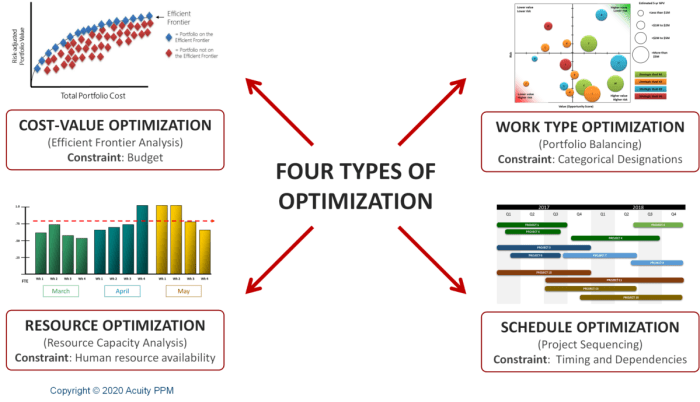
Portfolio Optimization Techniques sets the stage for this enthralling narrative, offering readers a glimpse into a story that is rich in detail with casual formal language style and brimming with originality from the outset.
Portfolio optimization involves fine-tuning investment portfolios through various techniques and mathematical models to maximize returns and minimize risks. In this overview, we delve into the key concepts and strategies that underpin this crucial aspect of financial management.
PORTFOLIO OPTIMIZATION TECHNIQUES

Portfolio optimization is the process of constructing a portfolio of assets in a way that maximizes returns for a given level of risk, or minimizes risk for a given level of return. It involves selecting the right combination of assets to achieve the desired investment objectives.
Common Portfolio Optimization Techniques
- Modern Portfolio Theory (MPT): Developed by Harry Markowitz, MPT is a key framework for portfolio optimization. It emphasizes diversification to achieve optimal risk-adjusted returns.
- Mean-Variance Optimization: This technique aims to maximize the expected return of a portfolio for a given level of risk, considering the mean return and variance of each asset in the portfolio.
- Black-Litterman Model: Combines investor views with market equilibrium to adjust asset allocation. It allows for incorporating subjective opinions into the optimization process.
Importance of Mathematical Models in Portfolio Optimization
Mathematical models play a crucial role in portfolio optimization by providing a systematic and quantitative approach to decision-making. They help investors analyze the risk-return trade-offs of different asset allocations and optimize portfolios based on specific objectives. By utilizing mathematical models, investors can make more informed and efficient investment decisions, leading to better portfolio performance and risk management.
PORTFOLIO DIVERSIFICATION
Portfolio diversification is a risk management strategy that involves spreading investments across a variety of assets to reduce exposure to any single asset or risk. This technique aims to maximize returns while minimizing the overall risk of the portfolio. Diversification is essential in investment because it helps protect against market volatility and unforeseen events that can impact individual assets.
Strategies for Achieving Effective Portfolio Diversification
Effective portfolio diversification can be achieved through the following strategies:
- Asset Allocation: Allocate investments across different asset classes such as stocks, bonds, real estate, and commodities to reduce risk.
- Correlation Analysis: Select assets that have low or negative correlations to each other to further diversify the portfolio.
- Rebalancing: Regularly review and adjust the portfolio to maintain the desired asset allocation and risk profile.
- Diversifying Geographically: Invest in assets from different regions or countries to reduce exposure to regional economic risks.
Benefits of Diversifying Across Asset Classes versus Within the Same Asset Class
When diversifying across asset classes:
- Reduces overall portfolio risk by not being overly dependent on a single asset class.
- Provides exposure to different market sectors, potentially increasing returns in various market conditions.
- Helps to hedge against inflation and economic downturns that may affect specific asset classes.
When diversifying within the same asset class:
- Allows for more focused investment strategies within a specific sector or industry.
- May still reduce risk compared to investing in a single asset, albeit to a lesser extent than diversifying across asset classes.
- Enables investors to capitalize on specific trends or opportunities within a particular asset class.
PORTFOLIO MANAGEMENT

Portfolio management plays a crucial role in ensuring that an investment portfolio remains balanced and aligned with the investor’s financial goals and risk tolerance.
Key principles of portfolio management include diversification, asset allocation, risk management, and regular monitoring and rebalancing of the portfolio. By diversifying investments across different asset classes and sectors, portfolio managers aim to reduce risk and enhance returns. Asset allocation involves determining the optimal mix of assets based on the investor’s risk appetite and investment objectives. Risk management strategies are implemented to protect the portfolio from potential losses and volatility.
Regular monitoring and rebalancing help ensure that the portfolio remains in line with the investor’s goals and market conditions.
Evolution of Portfolio Management Strategies
Portfolio management strategies evolve based on market conditions, economic trends, and advancements in financial theory. In times of economic uncertainty or market volatility, portfolio managers may implement defensive strategies to protect the portfolio from potential losses. On the other hand, during periods of economic growth and market expansion, managers may adopt more aggressive strategies to capitalize on emerging opportunities and maximize returns.
In conclusion, Portfolio Optimization Techniques play a vital role in shaping successful investment decisions. By understanding the intricacies of optimization methods and diversification strategies, investors can navigate the complex landscape of financial markets with confidence and precision.
Key Questions Answered
What is portfolio optimization?
Portfolio optimization refers to the process of selecting the best investment mix to achieve the highest returns for a given level of risk.
Why are mathematical models important in portfolio optimization?
Mathematical models help in analyzing historical data, predicting future trends, and optimizing investment portfolios efficiently.
What is portfolio diversification?
Portfolio diversification involves spreading investments across different assets to reduce risk and improve returns.
How do portfolio management strategies adapt to market conditions?
Portfolio management strategies adjust based on changing market dynamics, such as economic shifts, geopolitical events, and industry trends.





